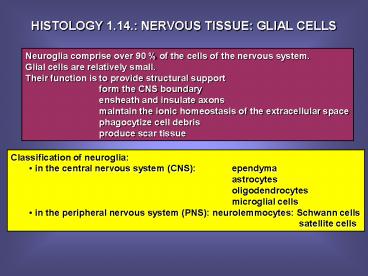1. dia - PowerPoint PPT Presentation
1 / 12
Title: 1. dia
1
HISTOLOGY 1.14. NERVOUS TISSUE GLIAL CELLS
Neuroglia comprise over 90 of the cells of the
nervous system. Glial cells are relatively
small. Their function is to provide structural
support form the CNS boundary ensheath and
insulate axons maintain the ionic homeostasis
of the extracellular space phagocytize cell
debris produce scar tissue
- Classification of neuroglia
- in the central nervous system (CNS) ependyma
- astrocytes
- oligodendrocytes
- microglial cells
- in the peripheral nervous system (PNS)
neurolemmocytes Schwann cells - satellite cells
2
Neuroglia of the CNS ependymal cells Ependymal
cells line ventricular cavities in the brain
and the central canal of the spinal
cord. They are cuboidal or columnar cells tightly
packed together. Their luminal surface is
ciliated and microvilliated. The cerebrospinal
fluid is produced by modified ependymal cells
(choroid plexus)
EM
LM
3
- Neuroglia of the CNS astrocytes
- They have the largest nuclei among glial cells.
- They are stellate-shaped with numerous processes
- in the white matter long slender processes
fibrous astrocytes - in the gray matter shorter branching
processes protoplasmic astrocytes. - They contain glial fibrillary acidic protein
(GFAP) forming glial filaments. - Astrocyte processes form expanding endfeets which
adjoin into limiting - membranes
- membrana limitans gliae superficialis (at the
surface of CNS) - membrana limitans gliae perivascularis
(blood-brain barrier). - Astrocytes provide structural support,
- form diffusion barriers around synapses,
- take up extracellular potassium ions
- are capable of phagocytosis
- proliferate to form a scar in the case of injury
4
- Schematic drawing of a protoplasmic
- astrocyte
- Nucleus
- Glial filaments
- Not found
- Capillary
- Endfeet of the astroglia around capillary
- Basal lamina of the capillary endothelium
- Endfeet around a synapse
- Presynaptic terminal
- Spiny dendrite
- Myelinated axon
- Initial segment of an axon
- Axo-axonic synapse
- Axospinous synapse
- Dendritic spine
5
Neuroglia of the CNS oligodendrocytes They have
small spherical nuclei in routinely stained
sections. Their processes are thin and difficult
to visualize. Their function in the gray matter
is perineuronal satellite-like, in white matter
they form the myelin sheaths around axons.
LM
- Oligodendrocyte
- Tapering process of oligodendrocyte
- Axon
- Myelin sheath
- Synapse at node of Ranvier
- Soma of a neuron
- Axon hillock
- Synaptic boutons
6
Neuroglia of the CNS microglia Microglia are
cells of mesodermal origin that invade the CNS
when it is vascularized. They have antigen
presenting and phagocytic abilities. They have
small elongated chromophilic nuclei.
Other cell types in the CNS with phagocytotic
activity astrocytes, oligodendrocytes,
pericytes, hematogenous macrophages
Silver impregnation
7
Neuroglia of the PNS neurolemmocytes They are
glial cells responsible for the myelination of
peripheral axons (Schwann cell), or encapsulate
neuronal cell bodies as satellite cells. They
provide a protected immediate environment for PNS
neurons. They can become phagocytic upon nerve
damage.
Cross-section of a myelinated peripheral axon at
the level of a Schwann cell nucleus
EM
LM
Schwann cells (arrows)
8
Satellite cells ( yellow arrow and no. 3) around
a pseudounipolar neuron from the spinal ganglion
9
NERVE FIBERS MYELINATED AXONS
Node of Ranvier
LM
LM
EM
Red arrow outer mesaxon Blue arrow inner
mesaxon Small red arrow neuro- filament Small
blue arrow micro- tubulus
EM
Cross-section
Longitudinal section
10
NERVE FIBERS NON-MYELINATED AXONS
Schwann cell nucleus Mesaxon Cross-section of
the axon
11
Structure of a peripheral nerve 1-6. Layers of
epineurium 7. Myelinated fiber with Schwann
cell 8. Non-myelinated fibers in a Schwann
cell 9. Capillary 10-11. Endoneurium
12. Perineurium 13. Fibrocyte
12
Thank you for your attention throughout the
whole semester































